Engineers report research milestones in fuel cells, flexible composites
Faculty and students in the University of Delaware’s College of Engineering continue to blaze a trail of innovation, reporting recent research milestones in flexible composites and fuel cells.
Flexible composites
The Chou research group recently reported success in fabricating flexible composites based on carbon nanotube (CNT) fibers in the high impact factor journal, Advanced Functional Materials (AFM). A micrograph image illustrating the pattern of a buckled CNT fiber in the stretchable conductor was selected as the journal’s cover photo for the January 2013 issue.
Both light and strong, carbon nanotubes (CNTs) are known as a revolutionary material with excellent mechanical, electrical and thermal properties. Continuous CNT fibers are one-dimensional assemblies of CNTs that show potential to retain the superb properties of individual CNTs on a macroscopic scale. They belong to a new class of nano-structured materials with potential applications in electronics, sensing and conducting wires.
Motivated by their high electrical conductivity and ability to kink without cracking, Tsu-Wei Chou, Pierre S. du Pont Chair of Engineering, and his research team used CNT fibers to fabricate a stretchable conductor. The result was a CNT fiber/PDMS flexible composite that can be subjected to repeated stretching-and-releasing cycles up to a prestrain level of 40 percent with little variation in electrical resistance.
According to the paper’s lead author Mei Zu, a visiting student from Tongji University in Shanghai, China, these findings demonstrate the potential of these flexible CNT fibers to be used as reinforcements for ultra-light weight multifunctional composites.
Under Chou’s guidance, Zu spent two years exploring the electrical and mechanical behavior of CNT-based fibers and composites as a doctoral student in UD’s Department of Mechanical Engineering and at the Center for Composite Materials.
This research was supported in part by the U.S. Air Force Office of Scientific Research and the National Research Foundation of Korea through the Global Research Laboratory program.
Platinum-free fuel cells
The Yan research group, led by Yushan Yan, Distinguished Professor of Engineering, is known for pioneering a new class of fuel cell membranes called hydroxide exchange membranes (HEMs). When used in fuel cells, HEMs enable non-platinum-group metals such as nickel and silver to replace expensive platinum catalysts.
Shuang Gu, a research assistant professor in Yan’s group, recently reported further progress toward eliminating precious metals, particularly platinum, from fuel cells in the Jan. 7 issue of Chemical Communications, a journal of the Royal Society of Chemistry.
Featured on the journal’s inside front cover, the article titled “An Efficient Ag–ionomer Interface for Hydroxide Exchange Membrane Fuel Cells” describes Gu’s work using the unique phosphonium polymer to create an efficient interface between the silver catalyst and the polymer electrolyte, which simultaneously enhances oxygen reduction activity and improves water and ion transport in fuel cells.
This work highlighted the fundamental impact of the polymer electrolyte on the catalyst, activity that had been overlooked in the past, and the result was a high-performance, completely-precious-metal-free HEM fuel cell, a milestone that could render fuel cells less expensive to produce.
“Shuang is a wonderful researcher and this work is another promising step in the push toward affordable HEMFC technologies,” said Yan, a co-author on the article and professor of chemical and biomolecular engineering.
The work is supported by the Department of Energy’s ARPA-E program, which is tasked with promoting and funding research and development of revolutionary energy technologies.
– Article by Karen B. Roberts
*Source: University of Delaware


